The industrial robotics market is estimated to be valued at USD 38.45 billion in 2025 and is expected to reach USD 95.08 billion by 2032, growing at a compound annual growth rate (CAGR) of 13.8% from 2025 to 2032.
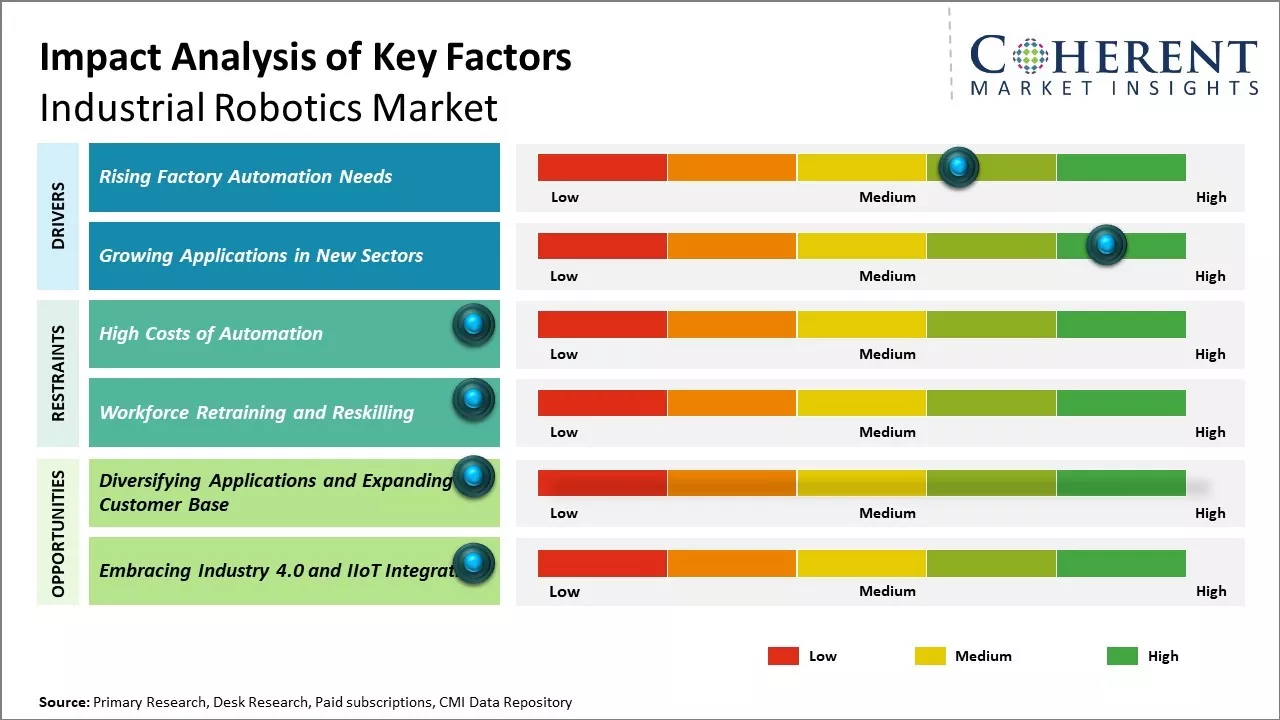
Discover market dynamics shaping the industry: Download Free Sample
The industrial robotics market is expected to witness substantial growth over the next few years. With the rising adoption of industrial automation across industries globally, including automotive, electronics, and food & beverages, there has been an increase in the demand for industrial robotics. Advanced technologies like machine learning and artificial intelligence are driving innovations in robotics that are making robots smarter, safer, and more collaborative to work with humans. This is increasing their applicability in warehouses and manufacturing facilities. Further, the demand for industrial robotics is expected to gain momentum with rising labor costs making automation economically viable particularly in developed markets. Key players are continuously focusing on the development of new products with advanced capabilities to strengthen their position in the industrial robotics market.
Rising Factory Automation Needs
With growing demand for faster and higher quality production, factories are under increasing pressure to automate their manufacturing processes. Labor costs have also been rising steadily over the years, giving businesses more incentive to reduce their reliance on human workers for repetitive and hazardous tasks. Industrial robots offer a solution to both these challenges by performing routine industrial jobs with high accuracy and precision, allowing 24/7 operations. They can work in hazardous environments without safety concerns and give consistent results time after time, thereby improving product quality. Furthermore, robotic systems take up little space on the factory floor and require low maintenance compared to human workers. All these advantages have been fuelling the automation of various manufacturing verticals such as automotive, electronics, pharmaceuticals, and food & beverage processing. Industry leaders are aggressively integrating more robotic applications to refine production workflows and meet customer expectations of customized, high-quality products at competitive prices.
For Instance, In July 2022, NACHI-FUJIKOSHI CORPORATION launched two new robots, MZ07F and MZ07LF, known for their high efficiency and speed. These robots are designed to enhance the productivity and precision of manufacturing miniature electronic and electrical components.
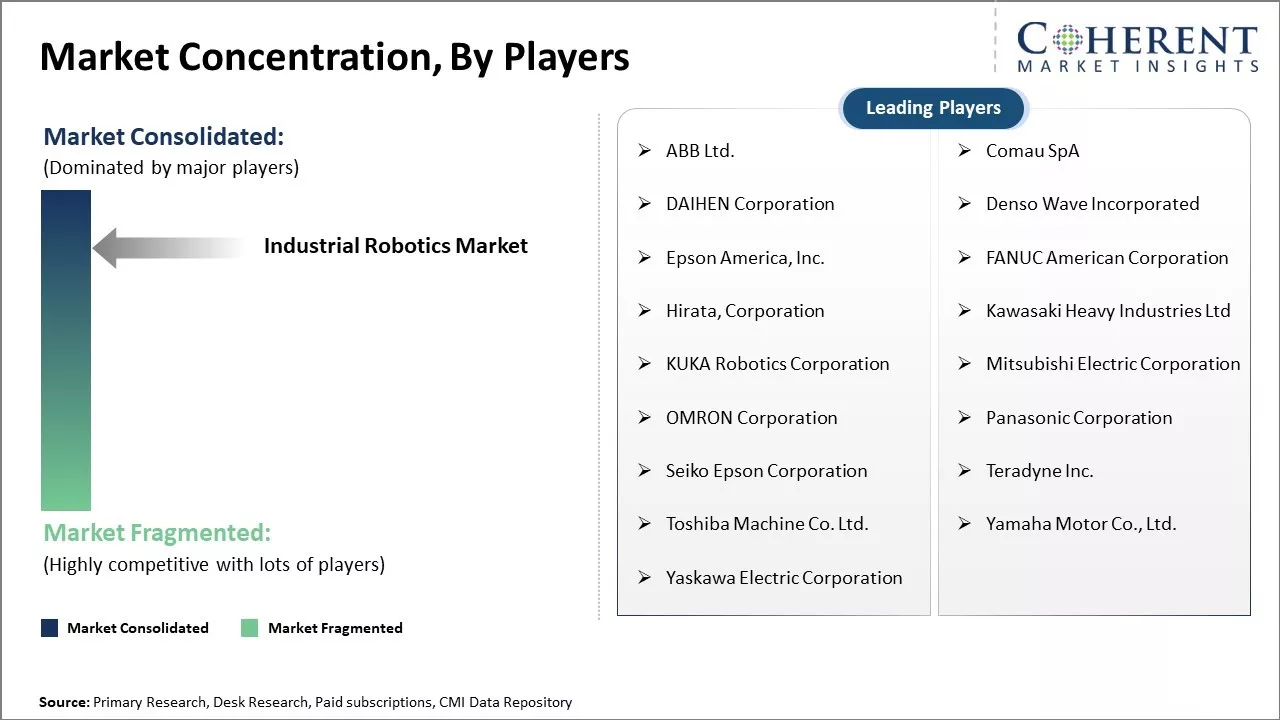
Get actionable strategies to beat competition: Download Free Sample
Growing Applications in New SectorsIndustrial robots were initially used mostly in automotive plants and electronics for tasks such as welding, assembly and packaging. However, their usage is expanding to newer application areas as technology advances make robots more collaborative, intelligent, and affordable. Some emerging sectors adopting robotics include logistics & warehousing for order fulfilment centers, e-commerce warehouses and distribution centers. Robots are aiding the materials handling, sorting, packaging, and delivery functions in these industries. Healthcare is another growing application area wherein robots assist in surgeries, rehabilitation, sample analysis and medical device production. Even food & beverage manufacturers are increasingly automating processes such as sorting, palletizing and packaging of products with robotics. Service robots for tasks like vacuum cleaning, lawn mowing and drone-based inspections are also gaining popularity in consumer applications. The diversifying demand across industries will be a major factor supporting the robotics market growth in the coming years.
For instance, in October 2022, ABB Robotic launched the smallest-ever industrial robot, IRB1010, catering to the demand in the smart device manufacturing industry. The robot is specifically designed for electronic gadgets manufacturing, including earphones, health trackers, smartwatches, and other devices.
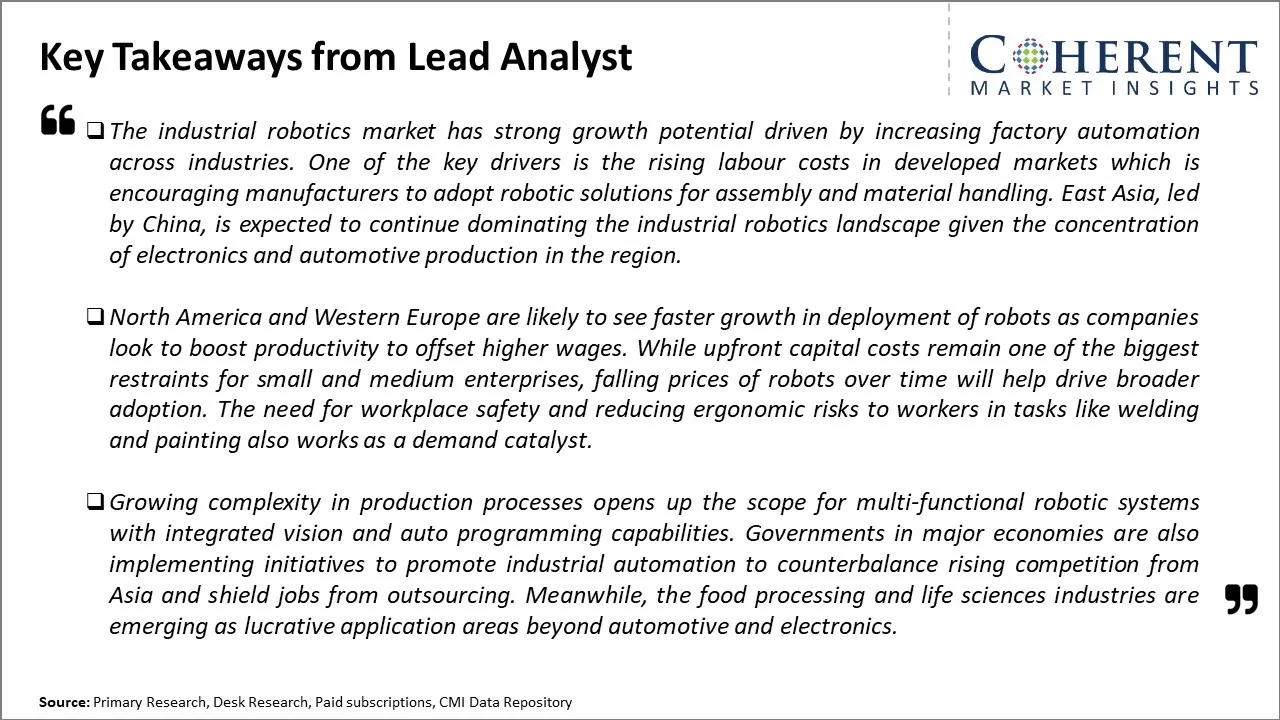
To learn more about this report, Download Free Sample
Market Challenges: High Costs of AutomationThe industrial robotics market faces several challenges. The high costs associated with automation equipment and deployment pose a significant barrier, especially for small and medium businesses. There are also challenges around retraining human workers as robots take over certain routine tasks. Furthermore, limited interconnectivity continues to hamper collaborative applications of robots working alongside humans. Safety also remains a top concern as greater interaction between robots and humans is required for true collaboration.
Market Opportunities: Diversifying Applications and Expanding Customer Base
On the other hand, the industrial robotics market also presents several opportunities. The growing demand from sectors like automotive, electronics, and food and beverage provides a stable customer base that will drive growth. The expanding applications of robotics in areas such as logistics, warehousing, and general assembly open up new revenue streams. Additionally, reducing hardware and Cloud connectivity is making Industrial Internet of Things (IIoT) applications more cost effective and scalable.
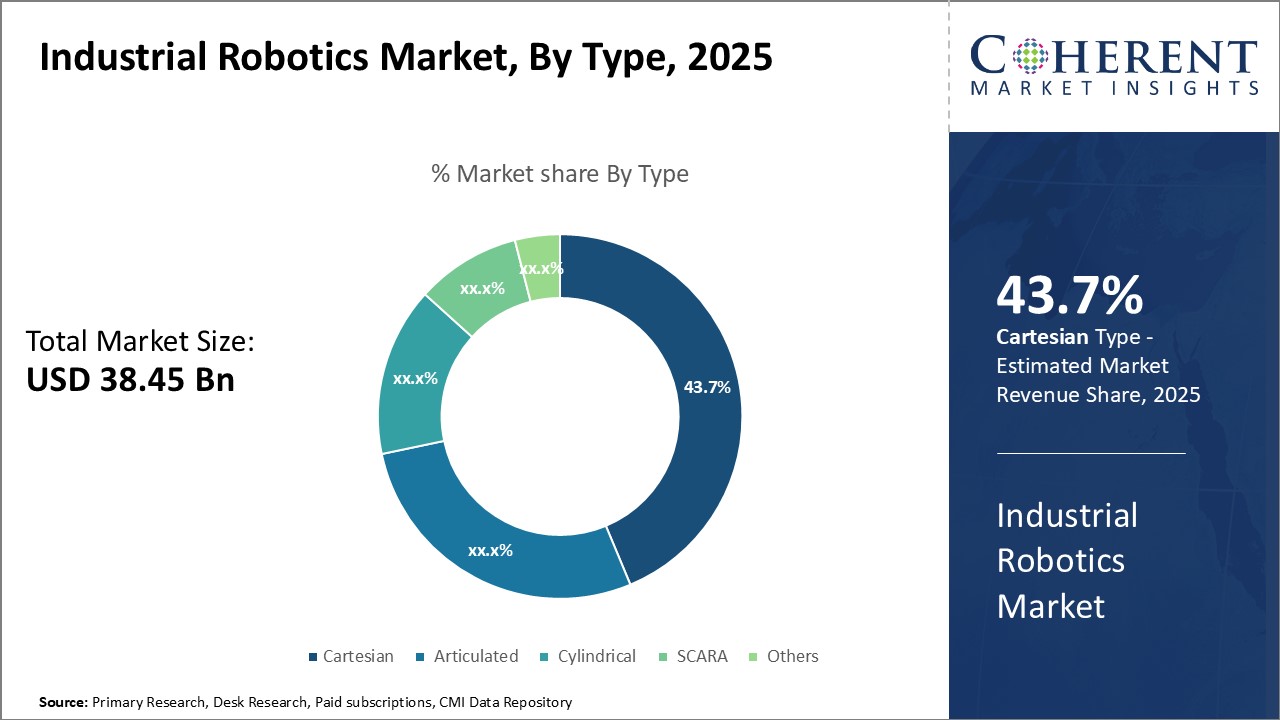
Discover high revenue pocket segments and roadmap to it: Download Free Sample
Insights, By Type- Precision Manufacturing is Pushing the Demand for Cartesian Industrial RobotsIn terms of type, cartesian robots is expected to contribute the highest share of 43.7% in 2025, owing to their widespread use in precision manufacturing applications across industries. Cartesian robots excel at applications that require accurate placement and movement of components or tools along up to three linear axes. Their simple linear arm movement makes them ideal for pick and place operations on assembly lines. Cartesian robots are also highly popular for applications like electronic component placement during circuit board assembly. Their accuracy of better than 0.02mm allows for precise placement of minute electronic components.
Cartesian robots are especially gaining prominence in industries like electronics and automotive that require high precision assembly of small components in large volumes. Their ability to perform intricate assembly tasks speeds up production and ensures consistency. The demand for next-generation consumer electronics with ever smaller components is driving the use of Cartesian robots. Similarly, the need for miniaturization and precision in automotive electronics is benefiting Cartesian robot adoption. Their high speed and versatility for tasks like gluing, joining, and dispensing also makes them suitable for plastics manufacturing applications.
Insights, By Industry- Electrical & Electronics Leads Demand in the Industrial Robotics Market by Industry
In terms of industry, the electrical and electronics sector is expected to contribute the highest share of 23.97% in 2025. Robots are increasingly being deployed across various electronics manufacturing sub-sectors including semiconductor, printed circuit board (PCB) assembly, surface mount technology (SMT) placement and final product assembly. Their high dexterity and precision allow for automated handling and assembly of small electronic components at high speeds. Electronic components are shrinking in size every year, requiring more delicate placement that can be reliably achieved through robotic automation.
Rising consumer demand for smart devices and gadgets has boosted production volumes for electronics OEMs. At the same time, cost pressure forces them to adopt automation to improve productivity. Industrial robots are empowering electronics manufacturers to meet growing order volumes for consumer electronics while maintaining stringent quality standards. They ensure consistent placement with minute tolerances required for today's compact semiconductor chips, connectors and other tiny parts. Robots can seamlessly integrate with existing assembly lines and easily switch between different component sizes through programmable commands. This flexibility combined with precision handling drives their widespread adoption in electronics assembly.
Insights, By Function- Materials Handling Dominates Industrial Robotics Function
In terms of function, materials handling is expected to contribute the highest share of 27.68% in 2025. Robots excel at logistical tasks like picking, packing, palletizing, and product sorting which are integral to automated warehousing and distribution facilities. They relieve human workers from repetitive lifting and transportation tasks, improving ergonomics. Their ability to carry heavy payloads accurately and smoothly compared to humans has boosted their popularity for materials handling applications across industries.
E-commerce boom is pushing demand for warehouse automation as online retailers look to optimize order fulfilment. There is increasing focus on reducing delivery times which requires swift materials movement within distribution centers. Industrial robots streamline intra-facility logistics through their quick handling speeds and smooth synchronization with conveyor systems. Automotive and electronics manufacturers also use robotic load handling within factories to improve workflow. They maximize production line uptime by swiftly moving components and raw materials between workstations.
Robotic arms for handling carry out tasks 24/7 tirelessly without breaks, a major productivity advantage. Their gripping tools can be customized for delicate or bulky payloads. Advanced force feedback and sensors allow safe interaction with humans in automated workplaces. Rapid advances in vision guidance and mobile robot platforms are further expanding materials handling capabilities. All these factors are positioning materials handling as a leading function driving future growth of industrial robotics.
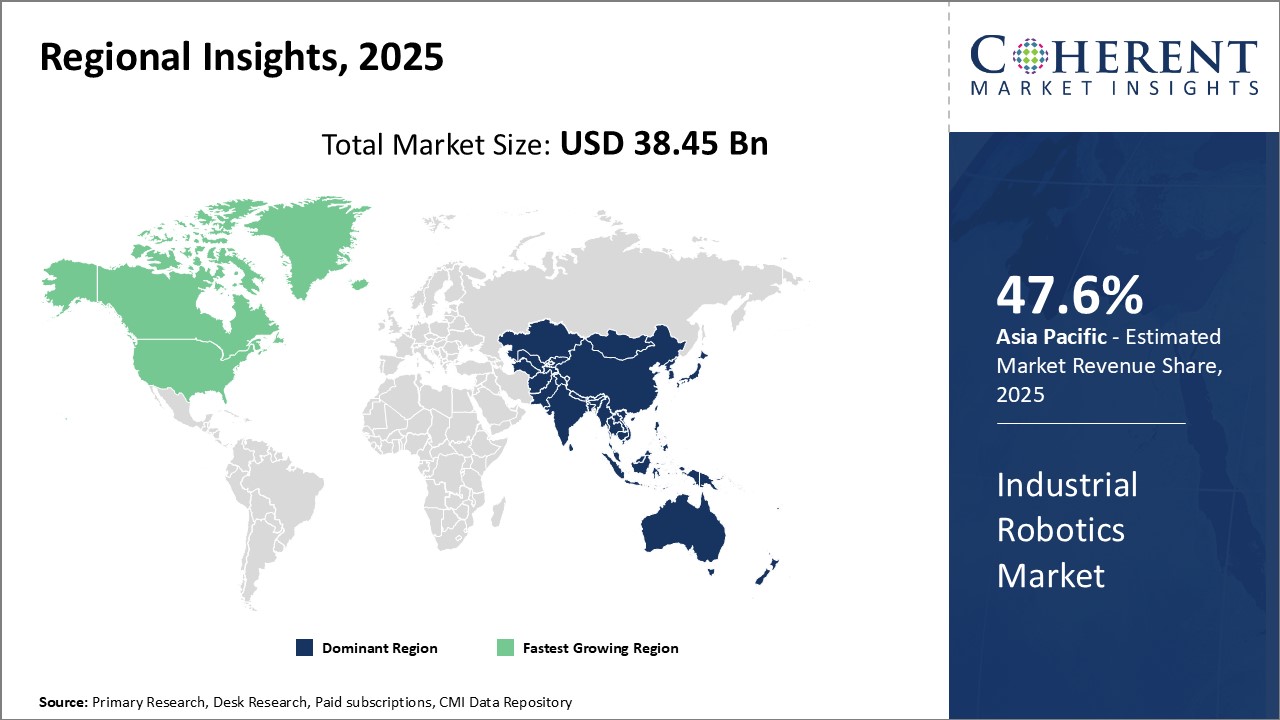
Need a Different Region or Segment? Download Free Sample
Asia Pacific, has emerged as the dominant region in the global industrial robotics market and is expected to have the highest market share of 47.6% in 2025, led by developing nations like China, Japan, and South Korea. China in particular stands out, given its massive manufacturing output and capacity expansion initiatives under the Made in China 2025 program. Chinese firms are investing heavily in automation to upgrade production capabilities and address rising labor costs. Rapid industrialization has spurred robot installations across automobile, electronics, machinery, and metal fabrication industries. Additionally, several global robotics leaders have established local manufacturing plants in China to capitalize on the surging demands.
Government mechanization subsidies and initiatives to develop smart manufacturing are fuelling robot deployment across diverse verticals. On the other hand, well-established robotics hubs like Japan and South Korea are focusing on technology upgrades involving collaborative robots, human-robot interaction, and AI-enabled solutions. The immense capital expenditure toward manufacturing modernization and technological sovereignty programs are propelling Asia Pacific to the forefront of the industrial robotics space.
North America is positioned as the fastest growing regional market and is expected to have the CAGR of 17.78% in 2025. The presence of large automotive, electronics, and healthcare industries has driven significant demand for robots in this region over the past decade. Major countries like the U.S. and Canada have developed advanced manufacturing infrastructure that continues to rely on automation solutions to improve productivity and minimize production costs. Strong government support for technological innovation and adoption of Industry 4.0 standards have encouraged industrial robotic deployments across various sectors.
Among countries, the U.S. accounts for the largest share of the regional market. The presence of prominent robotics companies and technological centers has created a vibrant ecosystem for the development of cutting-edge robotic solutions. Additionally, North American automakers are early adopters of robotics for vehicle assembly lines to enhance quality and efficiency. As labor costs rise, various other industries are increasingly investing in robotics to automate repetitive and dangerous tasks. The growing automation trends are projected to sustain North America's position as the most roboticized economy globally.
Industrial Robotics Market Report Coverage
| Report Coverage | Details | ||
|---|---|---|---|
| Base Year: | 2024 | Market Size in 2025: | USD 38.45 Bn |
| Historical Data for: | 2020 To 2024 | Forecast Period: | 2025 To 2032 |
| Forecast Period 2025 to 2032 CAGR: | 13.8% | 2032 Value Projection: | USD 95.08 Bn |
| Geographies covered: |
|
||
| Segments covered: |
|
||
| Companies covered: |
ABB Ltd., Comau SpA, DAIHEN Corporation, Denso Wave Incorporated, Epson America, Inc., FANUC American Corporation, Hirata, Corporation, Kawasaki Heavy Industries Ltd, KUKA Robotics Corporation, Mitsubishi Electric Corporation, OMRON Corporation, Panasonic Corporation, Seiko Epson Corporation, Teradyne Inc., Toshiba Machine Co. Ltd., Yamaha Motor Co., Ltd., and Yaskawa Electric Corporation |
||
| Growth Drivers: |
|
||
| Restraints & Challenges: |
|
||
Uncover macros and micros vetted on 75+ parameters: Get instant access to report
*Definition: The industrial robotics market refers to organizations that design, manufacture, and sell robots and robotic systems used for industrial automation applications across various industries including automotive, electronics, food and beverage, plastics, metals, and rubber. Key industrial robot types include articulated robots, SCARA robots, parallel robots, cartesian robots, and collaborative robots which are designed to work safely alongside or in close proximity to human workers without protective barriers. Some of the main applications of industrial robots include welding, assembly, material handling, and packaging.
Share
Share
About Author
Ramprasad Bhute is a Senior Research Consultant with over 6 years of experience in market research and business consulting. He manages consulting and market research projects centered on go-to-market strategy, opportunity analysis, competitive landscape, and market size estimation and forecasting. He also advises clients on identifying and targeting absolute opportunities to penetrate untapped markets.
Missing comfort of reading report in your local language? Find your preferred language :
Transform your Strategy with Exclusive Trending Reports :
Frequently Asked Questions
Joining thousands of companies around the world committed to making the Excellent Business Solutions.
View All Our Clients